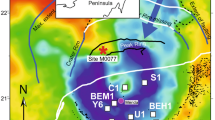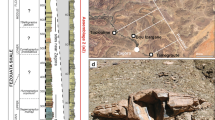Abstract
The rise and diversification of shelled invertebrate life in the early Phanerozoic eon occurred in two major stages. During the first stage (termed as the Cambrian explosion), a large number of new phyla appeared over a short time interval ∼540 Myr ago. Biodiversity at the family, genus and species level, however, remained low until the second stage marked by the Great Ordovician Biodiversification Event in the Middle Ordovician period1,2,3. Although this event represents the most intense phase of species radiation during the Palaeozoic era and led to irreversible changes in the biological make-up of Earth’s seafloors, the causes of this event remain elusive. Here, we show that the onset of the major phase of biodiversification ∼470 Myr ago coincides with the disruption in the asteroid belt of the L-chondrite parent body—the largest documented asteroid breakup event during the past few billion years4,5. The precise coincidence between these two events is established by bed-by-bed records of extraterrestrial chromite, osmium isotopes and invertebrate fossils in Middle Ordovician strata in Baltoscandia and China. We argue that frequent impacts on Earth of kilometre-sized asteroids—supported by abundant Middle Ordovician fossil meteorites and impact craters6—accelerated the biodiversification process.
This is a preview of subscription content, access via your institution
Access options
Subscribe to this journal
Receive 12 print issues and online access
$259.00 per year
only $21.58 per issue
Buy this article
- Purchase on Springer Link
- Instant access to full article PDF
Prices may be subject to local taxes which are calculated during checkout



Similar content being viewed by others
References
Sepkoski, J. J. Jr. A factor analytic description of the Phanerozoic marine fossil record. Paleobiology 7, 36–53 (1981).
Webby, B. D., Paris, F., Droser, M. L. & Percival, I. G. (eds) The Great Ordovician Biodiversification Event (Columbia Univ. Press, New York, 2004).
Harper, D. A. T. The Ordovician biodiversification: Setting an agenda for marine life. Palaeogeogr. Palaeoclimatol. Palaeoecol. 232, 148–166 (2006).
Heymann, D. On the origin of hypersthene chondrites: Ages and shock effects of black chondrites. Icarus 6, 189–221 (1967).
Keil, K., Haack, H. & Scott, E. R. D. Catastrophic fragmentation of asteroids: Evidence from meteorites. Planet. Space Sci. 42, 1109–1122 (1994).
Schmitz, B., Tassinari, M. & Peucker-Ehrenbrink, B. A rain of ordinary chondritic meteorites in the early Ordovician. Earth Planet. Sci. Lett. 194, 1–15 (2001).
Bridges, J. C. et al. Petrographic classification of mid-Ordovician fossil meteorites from Sweden. Meteorit. Planet. Sci. (2007, in the press).
Greenwood, R. C., Schmitz, B., Bridges, J., Hutchison, R. & Franchi, I. A. Disruption of the L chondrite parent body. New oxygen isotope evidence from Ordovician relict chromite grains. Earth Planet. Sci. Lett. 262, 204–213 (2007).
Schmitz, B., Häggström, T. & Tassinari, M. Sediment-dispersed extraterrestrial chromite traces a major asteroid disruption event. Science 300, 961–964 (2003).
Schmitz, B. & Häggström, T. Extraterrestrial chromite in Middle Ordovician marine limestone at Kinnekulle, southern Sweden—Traces of a major asteroid breakup event. Meteorit. Planet. Sci. 41, 455–466 (2006).
Häggström, T. & Schmitz, B. Distribution of extraterrestrial chromite in Middle Ordovician Komstad Limestone in the Killeröd quarry, Scania, Sweden. Bull. Geol. Soc. Den. 55, 37–58 (2007).
Heck, P. R., Schmitz, B., Baur, H., Halliday, A. N. & Wieler, R. Fast delivery of meteorites to Earth after a major asteroid collision. Nature 430, 323–325 (2004).
Korochantseva, E. V. et al. L-chondrite asteroid breakup tied to Ordovician meteorite shower by multiple isochron 40Ar–39Ar dating. Meteorit. Planet. Sci. 42, 113–130 (2007).
Droser, M. L. & Sheehan, P. M. Palaeoecology of the Ordovician radiation; resolution of large-scale patterns with individual clade histories, palaeogeography and environments. Geobios 30 (suppl. 1), 221–229 (1997).
Sepkoski, J. J. Jr. in Ordovician Odyssey: Short Papers for the Seventh International Symposium on the Ordovician System (eds Cooper, J. D., Droser, M. L. & Finney, S. C.) (Pacific Section Society for Sedimentary Geology, Book 77, Fullerton, California, 1995).
Hammer, Ø. Biodiversity curves for the Ordovician of Baltoscandia. Lethaia 36, 305–314 (2003).
Sweet, W. C. The Conodonta. Morphology, Taxonomy, Palaeoecology, and Evolutionary History of a Long-Extinct Animal Phylum (Clarendon, Oxford, 1988).
Peterson, K. J. Macroevolutionary interplay between planktic larvae and benthic predators. Geology 33, 929–932 (2005).
Vecoli, M., Lehnert, O. & Servais, T. The role of marine microphytoplankton in the Ordovician Biodiversification Event. Notebooks Geol. Memoir 2005/02, 69–70 (2005).
Cronholm, A. & Schmitz, B. Extraterrestrial chromite in latest Maastrichtian and Paleocene pelagic limestone at Gubbio, Italy: The flux of unmelted ordinary chondrites. Meteorit. Planet. Sci. (in the press).
Peucker-Ehrenbrink, B. & Ravizza, G. The marine osmium isotope record. Terra Nova 12, 205–219 (2000).
Rasmussen, C. M. Ø., Hansen, J. & Harper, D. A. T. Baltica: A mid Ordovician diversity hotspot. Hist. Biol. 19, 255–261 (2007).
Zappalà, V., Cellino, A., Gladman, B. J., Manley, S. & Migliorini, F. Asteroid showers on Earth after family breakup events. Icarus 134, 176–179 (1998).
Nesvorny, D., Vokrouhlicky, D., Bottke, W. F., Gladman, B. & Häggström, T. Express delivery of fossil meteorites from the inner asteroid belt to Sweden. Icarus 188, 400–413 (2007).
Alvarez, L. W., Alvarez, W., Asaro, F. & Michel, H. V. Extraterrestrial cause for the Cretaceous–Tertiary extinction. Science 208, 1095–1108 (1980).
Connell, J. H. Diversity in tropical rain forests and coral reefs. Science 199, 1302–1310 (1978).
Alwmark, C. & Schmitz, B. Extraterrestrial chromite in the resurge deposits of the early Late Ordovician Lockne crater, central Sweden. Earth Planet. Sci. Lett. 253, 291–303 (2007).
Zhang, J. Middle Ordovician Conodonts from the Atlantic Faunal Region and the Evolution of Key Conodont Genera. Thesis, Univ. Stockholm (1998).
Bottke, W. F., Vokrouhlicky, D. & Nesvorny, D. An asteroid breakup 160 Myr ago as the probable source of the K/T impactor. Nature 449, 48–53 (2007).
Peucker-Ehrenbrink, B., Bach, W., Hart, S. R., Blusztajn, J. S. & Abbruzzese, T. Rhenium-osmium isotope systematics and platinum group element concentrations in oceanic crust from DSDP/ODP Sites 504 and 417/418. Geochem. Geophys. Geosyst. 4, 8911 (2003).
Acknowledgements
This study was supported by financial support to B.S. from the National Geographic Society, Swedish Research Council (VR) and Crafoord Foundation and to D.A.T.H. from the Carlsberg Foundation. This is a contribution to International Geological Correlation Programme project 503.
Author information
Authors and Affiliations
Corresponding author
Supplementary information
Supplementary Information
Supplementary tables 1 and 2 (PDF 114 kb)
Rights and permissions
About this article
Cite this article
Schmitz, B., Harper, D., Peucker-Ehrenbrink, B. et al. Asteroid breakup linked to the Great Ordovician Biodiversification Event. Nature Geosci 1, 49–53 (2008). https://doi.org/10.1038/ngeo.2007.37
Received:
Accepted:
Published:
Issue Date:
DOI: https://doi.org/10.1038/ngeo.2007.37
This article is cited by
-
Karst Geoheritage of the Red Stone Forest in the Xiangxi UNESCO Global Geopark: Chromogenic Factors, Microgeomorphology and Dissolution Behaviour
Geoheritage (2024)
-
Impact of global climate cooling on Ordovician marine biodiversity
Nature Communications (2023)
-
Middle Ordovician astrochronology decouples asteroid breakup from glacially-induced biotic radiations
Nature Communications (2021)
-
U–Pb geochronology of apatite and zircon from the Brent impact structure, Canada: a Late Ordovician Sandbian–Katian boundary event associated with L-Chondrite parent body disruption
Contributions to Mineralogy and Petrology (2020)
-
Lower-middle Darriwilian index conodonts from the Precordillera: new taxonomical approaches
Palaeobiodiversity and Palaeoenvironments (2020)



